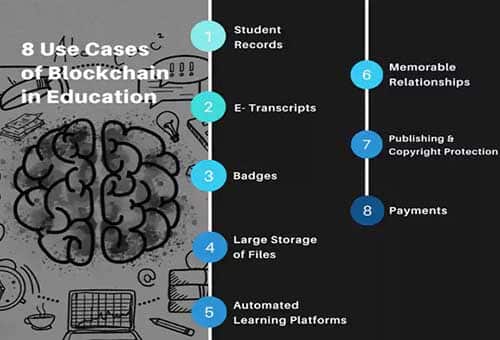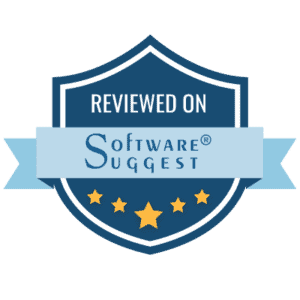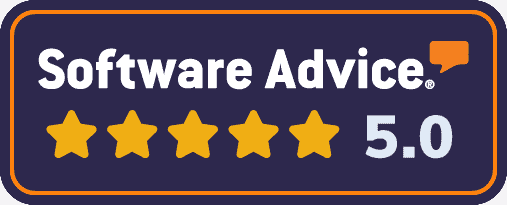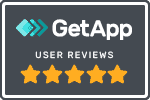We’ve clearly established that credential storage and verification is currently the primary Use Cases of Blockchain applied across institutions. Degrees, diplomas and certificates can be stored and issued on the blockchain. Instead of requesting to certify a paper copy, employers, universities, and schools will only need to provide a link to verify the diploma.
It also prevents people from submitting fake degrees to potential employers, a situation that is, regrettably, all too common. Skilled forgers constantly develop new techniques to forge fraudulent degrees to ensure they are undetectable. Blockchains can issue unique digital assets that verify the credentials of academic degrees and certifications.
Along with Credentials verification, there are various use cases of blockchain in the education and recruitment industries. Many of them are currently living in multiple universities. We have touched based on a few of them till now. However, let’s take an in-depth look at some of the practical Use Cases of Blockchain cases employed by other countries.
1. Student Records
Many universities across the globe have realized blockchain as the perfect solution for storing, tracking, and using students’ credentials. It allows students and learners to get fast and convenient access to their records and share it securely with potential employers. It also eases the burden on employers as they don’t have to go through their extensive background verification processes to confirm the student/applicant’s accomplishments.
A direct link to the student’s records on the blockchain will save time and give a complete picture of the skills & background of the student. The best part is that these records are not locked up in university servers, but they belong in the blockchain and the learners have complete control over them. They can easily use these records whenever a need occurs.
At the same time, Universities and recruiters don’t have to burden themselves in building a blockchain from scratch. There are many blockchain companies that facilitate the transition. There are existing blockchains such as Ethereum’s blockchain that facilitate storage as well as deploying smart contracts if a university chooses to do so. TruScholar has been assisting multiple recruiters, universities, and EdTech companies across the Indian Subcontinent in this transition.
Another type of student record that’s quite often requested is the course contents of a certification. In many scenarios, the course contents of a subject in one university or school may differ from another one. For example, the course content of Blockchain Technology as a subject may differ between schools. In this case, it becomes essential for recruiters or schools to understand what knowledge the candidate is equipped with.
Now, in a larger picture, it becomes extremely difficult when you are referring to courses that have hundreds to thousands of pages of course content. Again, confirming these contents manually continues to be a herculean task for many. Applying blockchain technology and storing all of this information related to the student makes it easier for all the parties involved. Storage, retrieval, and verification become much faster and simpler while retaining complete accuracy.
The best part about storing student records in blockchains is that it remains intact despite natural calamities, war afflictions, and server failures.
2. E- Transcripts
Tagging along with the ease of verification comes the brilliant possibility of ETranscripts. Be it India or anywhere else in the world, students are quite familiar with the slow speeds and high fees involved in requesting transcripts for college or job applications. Across multiple places in the world, the most labour-intensive and time-consuming task in academic institutions is producing Transcripts.
Each entry in a transcript needs to be manually verified to ensure accuracy. From high school to university, verifying transcripts still remains a manual process which involves case-by-case checking and a huge pile of paper documents. Even today, in 2020, a majority of institutions still rely on outdated methods such as physical mail to send and receive transcripts.
Distributed ledger technology and its solutions could easily streamline these procedures as well as minimize fraudulent claims of unearned educational credits. Blockchains can certainly prove to be a miracle for institutions to store confidential information, such as independent grades of a student, in a tamper-resistant way. Not only does it help educational institutions, but it also enables recruiters and manpower agencies for an easier vetting process. It saves a lot of time and money in the process.
3. Badges
Besides credentials, degrees & diplomas, a candidate’s typical resume contains a lot of additional information that’s relevant to employers or the position they’re applying for. We’re referring to technical knowledge, foreign language skills, or any other specific abilities related to a person’s profession.
It’s common to find people who are certified in one profession, yet they have many other skills that can prove beneficial to a recruiter or a university evaluating an application. Many-time, these additional skills aren’t easy to verify. But if the individual can get an expert third party to verify that skill and grant a badge or certificate then it becomes much easier to prove. Now, if these badges are stored on a blockchain, then it’s all the more convenient for the candidate.
4. Cost-effective Large Storage of Files
Storage of digital records, curricula, records, and degrees, is one side of the coin. However, blockchain and peer-to-peer systems can be used to do far more than save credentials. For example, with the help of the InterPlanetary File System (IPFS), a peer-to-peer storage system and smart contracts, universities can migrate all of their institutions’ records to decentralized and secure networks.
This involves bookkeeping, financial records, individual department records, and many more. It helps in easier maintenance and retrieval whenever a file is required. It also helps in effective auditing. Even course content can
Generally, this can use a lot of file storage space if stored in conventional means. Local storage and its related issues drive us back to the benefits of decentralization. If centralized servers get damaged or get compromised in any way, it will result in a major problem.
While cloud storage is an available option, the costs related to it may not be affordable by many institutions. This leads us to the various possibilities available in the blockchain world to store records. Institutions can benefit financially and technologically if they adopt file storage on Blockchain.
5. Automated Learning Platforms
With IPFS and Smart Contracts comes the possibility of storing course content and its easy access. It means that a lesson or course can be programmed into the blockchain for automatic execution upon satisfying certain conditions. This functionality unleashes new possibilities of automating lessons and courses.
For example, Massive Open Online Courses (MOOCs) can now be established by any university quite easily and not just EdTech companies. Here’s how the entire learning can be automated.
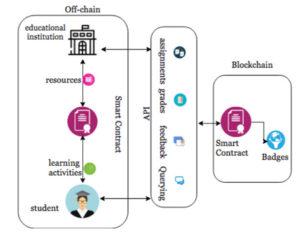
Another example of this application could be a teacher setting up a task for his/her students. When a student completes a task, the smart contract automatically verifies it. When all tasks are completed, both teachers and students are rewarded with crypto tokens & credits. Many universities are currently looking into this model, where they can automate large extensive courses, thereby saving time for students and teachers.
There are active learning platforms that use blockchain to connect students, academicians, content creators and developers. Making these platforms part of a university’s ecosystem allows learners to access study materials as well as share their ideas & projects. Internal tokens, incentives, and rewards for individual contributions will make it even productive.
6. Memorable Relationships
Relationships between professors and students last a lifetime. These relationships are crucial. When students get the right advice at the right time, they excel in their studies, get good grades, and they can complete their own assignments without relying on someone else to do it for them.
By employing smart contracts, professors in universities will spend less time managing and creating assignments, tests, and other mundane tasks. Instead they get to spend more time with the students in understanding their needs and providing one-to-one counselling.
Departments and its professors can also automate multiple activities such as grading, tests, posting information about important events and lectures, providing specific access to confidential records, and much more.
Such automation of regular tasks will lead to increased student-teacher time and thereby productive relationships. Every university should strive to establish these kinds of relationships between peers and professors. A failure to do so will affect the reputation of that university in the long term.
7. Publishing & Copyright Protection
In the last century, many research papers have been rejected for multiple reasons. Though some of these papers, and the researchers behind them, eventually won accolades such as Nobel Prizes; the initial rejection for publishing them is certainly a punch in the face to many graduates, scholars, and subject matter experts.
Likewise, many students, professors, teachers and researchers constantly generate quality material. However, the publication of this material is often very hard. Blockchain technology can change this situation.
When educational institutions implement blockchain technology they can assist their students and staff in publishing their research work easily. Publishing on a blockchain could help new writers, researchers and many others get a break into the industry without risking theft of their research work.
As records get stored in public key and private key format, the owner of the publication would be able to trace who is accessing and when they are accessing. So eventually, they decide when to give permission and when not to give permission to their hard work.
Copyright Protection
In the academic world, plagiarism is a serious problem. A research paper when stolen or copied can result in the loss of a lifetime’s work. An assignment stolen can result in low grades. Blockchain systems can be used to control the dispersal of copyrighted material across the Internet.
The secure storage of the information recorded in a chain will then become the primary function of the technology. Once stored, this data cannot be altered manually since advanced encryption protects it.
This enables access of the academic materials but in a secure way. The usage of content is also recorded into the chain, so the owner can easily control the access. The utilization can be tracked online, and ownership is easily proved.
8. Payment via Cryptocurrencies
Of course, with cryptocurrencies, it becomes easier to perform transactions. Payments from students in one end of the world to the universities on the other side of the world can be done in seconds to minutes. Several universities such as Simon Fraser University in British Columbia, the University of Nicosia, and King’s College in New York accept cryptocurrencies from their students. A lot of middlemen fees can be avoided by doing so and it saves a lot of costs for the universities.
Conclusion
Corporations and institutions continue to study the technology in combination with leading technologies such as AI, IoT, ML, AR/VR, and more. At the same time, the number of blockchains have increased to include hybrid blockchains and federated blockchain.
As blockchain technology continues to grow rapidly, its Use Cases of Blockchain in the education industry are bound to multiply. Decentralized applications for robust security systems and infrastructure in universities have been in implementation stages recently.
There is no limit to how the Use Cases of Blockchain technology to achieve the best results for everyday challenges. At TruScholar, we are committed to using this technology for improving education systems across the globe.
Subscribe to our weekly newsletter to learn more about the Use Cases of Blockchain. Until next time, have a nice day!

